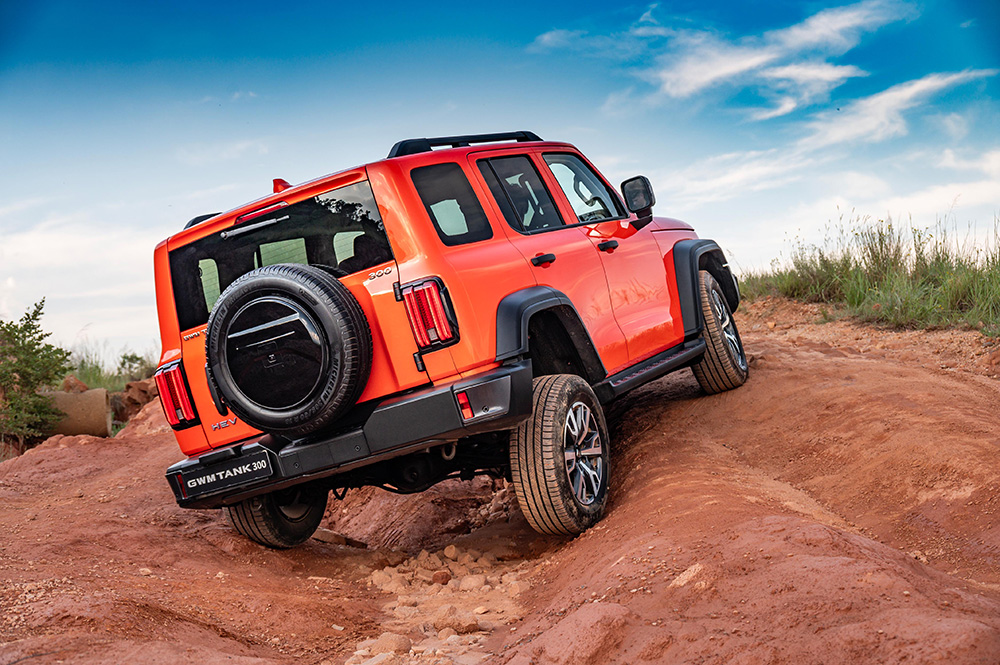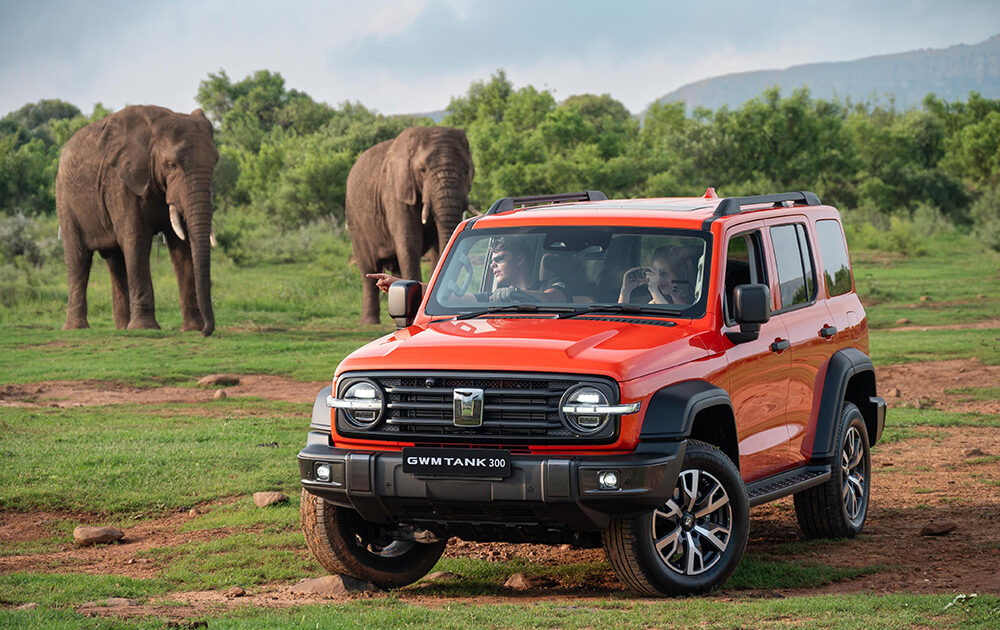The last tank battle in Southern Africa took place 35 years ago during the Battle of Cuito Cuanavale fought between 1987 and 1988 in Angola but now there is a new Tank from China ready to take on rivals in the ladder-frame based SUV class. We recently got acquainted with the GWM Tank 300 during an introductory trip to Limpopo Province.
The Battle of Cuito Cuanavale was the biggest conventional battle in Southern Africa since World War II and during this campaign Olifant tanks from the former SADF clashed with T45/55 tanks of Fapla, the Angolan army.
Interestingly, these Soviet-era tanks (as well as the Russian T-62) served as base for the development of the Type 59 and its successor, the Type 69 – the first indigenously developed tank of the People’s Republic of China.
The Type 62, introduced sixty years ago, is still operational in certain parts of the world but in South Africa a completely new Chinese “tank” recently made its debut – under the flag of auto giant Great Wall Motors (GWM).
For its intended assault on the competitive and highly contested niche market for off-road oriented SUVs, GWM decided to send in the cavalry … by establishing a completely new brand called Tank. Now the Tank 300 is apparently ready to take on rivals in the ladder-frame based SUV segment.
Opponents in this class include the Toyota Fortuner, Ford Everest, Isuzu Mu-X, and Mitsubishi Pajero Sport but for some reason GWM refrained from listing Indian and Chinese models, such as the Mahindra Scorpio-N and the BAIC B40 Plus.
Looking at the Tank 300, it is clear GWM took the advice of the Chinese military general Sun Tzu to heart (know your enemy, know yourself) as the design of the GWM product mimics the boxy lines of classic off-road vehicles such as the Jeep Wrangler, the Mercedes-Benz G-Class, the original Land Rover Defender (and now also the Ineos Grenadier), the Ford Bronco, and Toyota FJ Cruiser.
The only styling elements that distinguish the Tank 300 from the rest are its LED DRLs cutting through the LED headlamps from outside (in contrast to the Bronco with DRLs dissecting the main lamps from inside) and the Tank logo (yes, it does remind one of Iron Man …) consisting of a stylised T and U.
This depicts the focus of the trade name on technology and trend, as well as the customer (“user”, phonetically referred to as “you”, as well as to “unite”). The rest of the design (clam shell bonnet with power bulge, prominent wheel arches and cladding, side steps, and the spare tyre at the rear), its chassis layout (based on the P-Series), and suspension system follows the traditional off-road route.

Lavishly equipped
Despite its name, the Tank 300, according to GWM, is the most luxurious and lavishly equipped vehicle in its class and our first impressions of the HEV Super Luxury models (the only versions available now, with the petrol models to follow shortly) at The Cradle launch venue confirmed this.
The quilted leather seats, with six-way electric adjustment for the driver and four-way adjustment for the front passenger, proved quite comfortable and the spacious cabin was dominated by two 12.3-inch high-definition LCD screens for the instrument panel and infotainment system (with Apple CarPlay and Android Auto compatibility).
Besides normal functions, the surround-view camera system in the Tank also fully controls the off-road functions, providing information on height above sea level, compass direction, body roll angle, steering and wheel angles, as well as tyre pressures. A choice of seven ambient light colours is available (64 in the Ultra Luxury models).
The list of luxury equipment (even more comprehensive than in the top model Everest) also includes double-zone climate control, auto lights and wiper control, a soundproof windshield, lots of grab handles, a high-quality sound system, type A and C charging ports, and a 12V power outlet (220V in the Super Luxury model).
Our route towards Monate Game Reserve included highways, pothole strewn back roads, and semi-wet gravel roads and the standout features during our drive was the impressive sound insulation in the cabin of the Tank 300 HEV, and its ride comfort on all types of road surfaces – even with hard pumped 18-inch Michelin tyres.
Steering feel was light at low speeds but firmed up gradually. It can also be set via different modes, but it took us a while to figure out the positioning and operation of the controls. Also to cancel the overzealous lane keeping assist functions, and we found the warning bells and hard ticking sound of the indicators quite disturbing.
Still, these small irritations do not detract from the relaxed atmosphere and fine driving experience of the chunky off-road ready SUV powered by the proven two-litre four-cylinder petrol turbo engine from GWM, delivering 180 kW and 380 Nm of torque.
In the HEV, the drivetrain includes a 78 kW electric motor and a 37.11 kWh battery, for combined power delivery of 255 kW and a hefty 648 Nm of torque (258 Nm provided by the electric motor). In comparison, the petrol-only models will have 162 kW and 380 Nm on tap.
With substantial electric boost and coupled with a smooth-working nine-speed hydraulic automatic transmission, the engine had no trouble propelling the heavy Tank (it weighs about 2.4 ton) from standstill to cruising speeds, but the smallish engine became quite vocal at high revs.
Considering it is a heavy vehicle based on a ladder frame chassis, the Tank was surprisingly well-behaved in the corners, mostly due to its permanent four-wheel-drive system, although the handling safety systems still kicked in far too premature.
Although the iBooster braking system harvested some energy, and the Tank went into full-electric mode at very low speeds, petrol consumption on tarred roads was quite high – around 11 ℓ/100 km (compared to the 8.4 ℓ/100 km claimed by GWM).

Off-road Competent
Contrary to the petrol models, with selectable non-permanent four-wheel-drive systems, the HEV model has electronically controlled permanent all-wheel-drive coupled to a low-range gearbox with different driving modes (Normal, Eco, Sport, Rock, Snow, and Sand).
This clever system, in tandem with an electronic limited-slip diff on the rear axle, 224 mm of ground clearance and approach angle of 33 degrees, breakover angle of 23,1 degrees, and departure angle of 34 degrees (without tow hitch) made the Tank highly off-road competent – as we experienced on a short off-road route with many tough obstacles at the De Wildt 4×4 track close to Brits in Northwest Province.
With a 70 degree climb gradient, 700 mm wading depth, and additional off-road assistance systems such as the Tank Turn system to shorten its turning circle, surround-view cameras, and off-road speed control, the GWM Tank loses no ground to any of its rivals in terms of 4×4 prowess.
The Chinese SUV also received a five-star safety grading from ANCAP and its highly competitive retail price of R851 950 includes an extensive warranty (seven-year/200 000 km), service plan (five-year/75 000 km), and battery warranty (eight-year/150 000 km).
Our initial experience with the Tank 300 made it clear that GWM did proper preparation for this assault, and the impressive debut model (yes, a full range is expected) has enough fire power to establish a sturdy bridgehead in the competitive market segment. But will it be enough to conquer Fort Fortuner?
Text: Ferdi de Vos | Images: GWM South Africa


